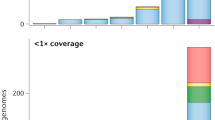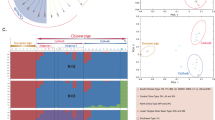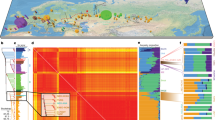Abstract
Traditionally, the process of domestication is assumed to be initiated by humans, involve few individuals and rely on reproductive isolation between wild and domestic forms. We analyzed pig domestication using over 100 genome sequences and tested whether pig domestication followed a traditional linear model or a more complex, reticulate model. We found that the assumptions of traditional models, such as reproductive isolation and strong domestication bottlenecks, are incompatible with the genetic data. In addition, our results show that, despite gene flow, the genomes of domestic pigs have strong signatures of selection at loci that affect behavior and morphology. We argue that recurrent selection for domestic traits likely counteracted the homogenizing effect of gene flow from wild boars and created 'islands of domestication' in the genome. Our results have major ramifications for the understanding of animal domestication and suggest that future studies should employ models that do not assume reproductive isolation.
This is a preview of subscription content, access via your institution
Access options
Subscribe to this journal
Receive 12 print issues and online access
$209.00 per year
only $17.42 per issue
Buy this article
- Purchase on Springer Link
- Instant access to full article PDF
Prices may be subject to local taxes which are calculated during checkout





Similar content being viewed by others
Accession codes
References
Childe, V.G. The Dawn of European Civilization 6th edn. (Routledge & Kegan Paul, 1968).
Darwin, C. The Variation of Animals and Plants Under Domestication (John Murray, 1868).
Price, E.O. Animal Domestication and Behavior (CABI Publishing, 2002).
Driscoll, C.A., Macdonald, D.W. & O'Brien, S.J. From wild animals to domestic pets, an evolutionary view of domestication. Proc. Natl. Acad. Sci. USA 106, 9971–9978 (2009).
O'Connor, T.P. Wild or domestic? Biometric variation in the cat Felis silvestris Schreber. Int. J. Osteoarchaeol. 17, 581–595 (2007).
Larson, G. et al. Worldwide phylogeography of wild boar reveals multiple centers of pig domestication. Science 307, 1618–1621 (2005).
Hanotte, O. et al. African pastoralism: genetic imprints of origins and migrations. Science 296, 336–339 (2002).
Luikart, G. et al. Multiple maternal origins and weak phylogeographic structure in domestic goats. Proc. Natl. Acad. Sci. USA 98, 5927–5932 (2001).
Naderi, S. et al. The goat domestication process inferred from large-scale mitochondrial DNA analysis of wild and domestic individuals. Proc. Natl. Acad. Sci. USA 105, 17659–17664 (2008).
Pedrosa, S. et al. Evidence of three maternal lineages in Near Eastern sheep supporting multiple domestication events. Proc. Biol. Sci. 272, 2211–2217 (2005).
Vilà, C. et al. Widespread origins of domestic horse lineages. Science 291, 474–477 (2001).
Larson, G. & Fuller, D.Q. The evolution of animal domestication. Annu. Rev. Ecol. Evol. Syst. 45, 115–136 (2014).
Zeder, M.A. Domestication and early agriculture in the Mediterranean Basin: origins, diffusion, and impact. Proc. Natl. Acad. Sci. USA 105, 11597–11604 (University of Oklahoma Press, 2008).
Macneish, R.S. The Origins of Agriculture and Settled Life (University of Oklahoma Press, 1992).
Zeder, M.A. in Harlan II: Biodiversity in Agriculture: Domestication, Evolution and Sustainability (eds. Damania, A. & Gepts, P.) 227–229 (Univ. California Press, 2011).
Vigne, J.-D. The origins of animal domestication and husbandry: a major change in the history of humanity and the biosphere. C. R. Biol. 334, 171–181 (2011).
Dobney, K. & Larson, G. Genetics and animal domestication: new windows on an elusive process. J. Zool. (Lond.) 269, 261–271 (2006).
Marshall, F.B., Dobney, K., Denham, T. & Capriles, J.M. Evaluating the roles of directed breeding and gene flow in animal domestication. Proc. Natl. Acad. Sci. USA 111, 6153–6158 (2014).
Ervynck, A., Hongo, H., Dobney, K. & Meadow, R. Born free? New evidence for the status of Sus scrofa at Neolithic Çayönü Tepesi (Southeastern Anatolia, Turkey). Paléorient 27, 47–73 (2001).
Cucchi, T., Hulme-Beaman, A., Yuan, J. & Dobney, K. Early Neolithic pig domestication at Jiahu, Henan Province, China: clues from molar shape analyses using geometric morphometric approaches. J. Archaeol. Sci. 38, 11–22 (2011).
Larson, G. et al. Ancient DNA, pig domestication, and the spread of the Neolithic into Europe. Proc. Natl. Acad. Sci. USA 104, 15276–15281 (2007).
Ottoni, C. et al. Pig domestication and human-mediated dispersal in western Eurasia revealed through ancient DNA and geometric morphometrics. Mol. Biol. Evol. 30, 824–832 (2013).
Albarella, U., Manconi, F. & Trentacoste, A. in Ethnozooarchaeology. The Present and Past of Human-Animal Relationships (eds. Albarella, U. & Trentacoste, A.) 143–159 (Oxbow Books, 2011).
White, S. From globalized pig breeds to capitalist pigs: a study in animal cultures and evolutionary history. Environ. Hist. 16, 94–120 (2011).
Evin, A. et al. The long and winding road: identifying pig domestication through molar size and shape. J. Archaeol. Sci. 40, 735–743 (2013).
Albarella, U., Davis, S.J.M., Detry, C.P. & Rowley-Conwy, P. Pigs of the 'Far West': the biometry of Sus from archaeological sites in Portugal. Anthropozoologica 40, 27–54 (2005).
Rowley-Conwy, P., Albarella, U. & Dobney, K. Distinguishing wild boar from domestic pigs in prehistory: a review of approaches and recent results. J. World Prehist. 25, 1–44 (2012).
Owen, J. et al. The zooarchaeological application of quantifying cranial shape differences in wild boar and domestic pigs (Sus scrofa) using 3D geometric morphometrics. J. Archaeol. Sci. 43, 159–167 (2014).
Porter, V. Pigs: A Handbook to the Breeds of the World (Helm Information, 1993).
Groenen, M.A.M. et al. Analyses of pig genomes provide insight into porcine demography and evolution. Nature 491, 393–398 (2012).
Bosse, M. et al. Genomic analysis reveals selection for Asian genes in European pigs following human-mediated introgression. Nat. Commun. 5, 4392 (2014).
Bosse, M. et al. Untangling the hybrid nature of modern pig genomes: a mosaic derived from biogeographically distinct and highly divergent Sus scrofa populations. Mol. Ecol. 23, 4089–4102 (2014).
Frantz, L.A. et al. Genome sequencing reveals fine scale diversification and reticulation history during speciation in Sus. Genome Biol. 14, R107 (2013).
Bosse, M. et al. Regions of homozygosity in the porcine genome: consequence of demography and the recombination landscape. PLoS Genet. 8, e1003100 (2012).
Frantz, L.A.F., Madsen, O., Megens, H.-J., Groenen, M.A.M. & Lohse, K. Testing models of speciation from genome sequences: divergence and asymmetric admixture in Island Southeast Asian Sus species during the Plio-Pleistocene climatic fluctuations. Mol. Ecol. 23, 5566–5574 (2014).
Ai, H. et al. Adaptation and possible ancient interspecies introgression in pigs identified by whole-genome sequencing. Nat. Genet. 47, 217–225 (2015).
Nielsen, R. et al. Genomic scans for selective sweeps using SNP data. Genome Res. 15, 1566–1575 (2005).
Pavlidis, P., Živkovic, D., Stamatakis, A. & Alachiotis, N. SweeD: likelihood-based detection of selective sweeps in thousands of genomes. Mol. Biol. Evol. 30, 2224–2234 (2013).
Huber, C.D., Nordborg, M., Hermisson, J. & Hellmann, I. Keeping it local: evidence for positive selection in Swedish Arabidopsis thaliana. Mol. Biol. Evol. 31, 3026–3039 (2014).
Andersson-Eklund, L. et al. Mapping quantitative trait loci for carcass and meat quality traits in a wild boar × Large White intercross. J. Anim. Sci. 76, 694–700 (1998).
Rubin, C.-J. et al. Strong signatures of selection in the domestic pig genome. Proc. Natl. Acad. Sci. USA 109, 19529–19536 (2012).
Karim, L. et al. Variants modulating the expression of a chromosome domain encompassing PLAG1 influence bovine stature. Nat. Genet. 43, 405–413 (2011).
Setoguchi, K. et al. Cross-breed comparisons identified a critical 591-kb region for bovine carcass weight QTL (CW-2) on chromosome 6 and the Ile-442-Met substitution in NCAPG as a positional candidate. BMC Genet. 10, 43 (2009).
Quartu, M. et al. Neurturin, persephin, and artemin in the human pre- and full-term newborn and adult hippocampus and fascia dentata. Brain Res. 1041, 157–166 (2005).
Simanainen, U. et al. Evidence for increased tissue androgen sensitivity in neurturin knockout mice. J. Endocrinol. 218, 151–163 (2013).
Oschipok, L.W., Teh, J., McPhail, L.T. & Tetzlaff, W. Expression of Semaphorin3C in axotomized rodent facial and rubrospinal neurons. Neurosci. Lett. 434, 113–118 (2008).
Hernández-Montiel, H.L., Tamariz, E., Sandoval-Minero, M.T. & Varela-Echavarría, A. Semaphorins 3A, 3C, and 3F in mesencephalic dopaminergic axon pathfinding. J. Comp. Neurol. 506, 387–397 (2008).
Gonthier, B. et al. Functional interaction between matrix metalloproteinase-3 and semaphorin-3C during cortical axonal growth and guidance. Cereb. Cortex 17, 1712–1721 (2007).
Ruediger, T. et al. Integration of opposing semaphorin guidance cues in cortical axons. Cereb. Cortex 23, 604–614 (2013).
Niquille, M. et al. Transient neuronal populations are required to guide callosal axons: a role for semaphorin 3C. PLoS Biol. 7, e1000230 (2009).
Pasterkamp, R.J., Kolk, S.M., Hellemons, A.J.C.G.M. & Kolodkin, A.L. Expression patterns of semaphorin7A and plexinC1 during rat neural development suggest roles in axon guidance and neuronal migration. BMC Dev. Biol. 7, 98 (2007).
Brown, C.B. et al. PlexinA2 and semaphorin signaling during cardiac neural crest development. Development 128, 3071–3080 (2001).
Ultanir, S.K. et al. Chemical genetic identification of NDR1/2 kinase substrates AAK1 and Rabin8 uncovers their roles in dendrite arborization and spine development. Neuron 73, 1127–1142 (2012).
Chevallier, J. et al. Rab35 regulates neurite outgrowth and cell shape. FEBS Lett. 583, 1096–1101 (2009).
Ong, S.H. et al. FRS2 proteins recruit intracellular signaling pathways by binding to diverse targets on fibroblast growth factor and nerve growth factor receptors. Mol. Cell. Biol. 20, 979–989 (2000).
Sokol, D.K. et al. High levels of Alzheimer β-amyloid precursor protein (APP) in children with severely autistic behavior and aggression. J. Child Neurol. 21, 444–449 (2006).
Grayton, H.M., Missler, M., Collier, D.A. & Fernandes, C. Altered social behaviours in neurexin 1α knockout mice resemble core symptoms in neurodevelopmental disorders. PLoS ONE 8, e67114 (2013).
Bhoiwala, D.L. et al. Overexpression of RCAN1 isoform 4 in mouse neurons leads to a moderate behavioral impairment. Neurol. Res. 35, 79–89 (2013).
Dierssen, M. et al. Behavioral characterization of a mouse model overexpressing DSCR1/RCAN1. PLoS ONE 6, e17010 (2011).
Kim, K.S., Larsen, N., Short, T., Plastow, G. & Rothschild, M.F. A missense variant of the porcine melanocortin-4 receptor (MC4R) gene is associated with fatness, growth, and feed intake traits. Mamm. Genome 11, 131–135 (2000).
Xu, P. et al. Double deletion of melanocortin 4 receptors and SAPAP3 corrects compulsive behavior and obesity in mice. Proc. Natl. Acad. Sci. USA 110, 10759–10764 (2013).
Valette, M. et al. Eating behaviour in obese patients with melanocortin-4 receptor mutations: a literature review. Int. J. Obes. (Lond.) 37, 1027–1035 (2013).
Wojcik, S.M. et al. Genetic markers of a Munc13 protein family member, BAIAP3, are gender specifically associated with anxiety and benzodiazepine abuse in mice and humans. Mol. Med. 19, 135–148 (2013).
Garud, N.R., Messer, P.W., Buzbas, E.O. & Petrov, D.A. Recent selective sweeps in North American Drosophila melanogaster show signatures of soft sweeps. PLoS Genet. 11, e1005004 (2015).
Freedman, A.H. et al. Genome sequencing highlights the dynamic early history of dogs. PLoS Genet. 10, e1004016 (2014).
Warmuth, V. et al. Reconstructing the origin and spread of horse domestication in the Eurasian steppe. Proc. Natl. Acad. Sci. USA 109, 8202–8206 (2012).
Turner, T.L., Hahn, M.W. & Nuzhdin, S.V. Genomic islands of speciation in Anopheles gambiae. PLoS Biol. 3, e285 (2005).
Ludwig, A. et al. Twenty-five thousand years of fluctuating selection on leopard complex spotting and congenital night blindness in horses. Phil. Trans. R. Soc. Lond. B 370, 20130386 (2015).
Vilà, C., Seddon, J. & Ellegren, H. Genes of domestic mammals augmented by backcrossing with wild ancestors. Trends Genet. 21, 214–218 (2005).
Carneiro, M. et al. Rabbit genome analysis reveals a polygenic basis for phenotypic change during domestication. Science 345, 1074–1079 (2014).
Pickrell, J.K. & Reich, D. Toward a new history and geography of human genes informed by ancient DNA. Trends Genet. 30, 377–389 (2014).
Larson, G. & Burger, J. A population genetics view of animal domestication. Trends Genet. 29, 197–205 (2013).
Girdland Flink, L. et al. Establishing the validity of domestication genes using DNA from ancient chickens. Proc. Natl. Acad. Sci. USA 111, 6184–6189 (2014).
Alexander, D.H., Novembre, J. & Lange, K. Fast model-based estimation of ancestry in unrelated individuals. Genome Res. 19, 1655–1664 (2009).
McKenna, A. et al. The Genome Analysis Toolkit: a MapReduce framework for analyzing next-generation DNA sequencing data. Genome Res. 20, 1297–1303 (2010).
Frantz, L.A.F. et al. Evolution of Tibetan wild boars. Nat. Genet. 47, 188–189 (2015).
Hudson, R.R. Generating samples under a Wright-Fisher neutral model of genetic variation. Bioinformatics 18, 337–338 (2002).
Thornton, K. libsequence: a C++ class library for evolutionary genetic analysis. Bioinformatics 19, 2325–2327 (2003).
Peter, B.M., Huerta-Sanchez, E. & Nielsen, R. Distinguishing between selective sweeps from standing variation and from a de novo mutation. PLoS Genet. 8, e1003011 (2012).
Wegmann, D., Leuenberger, C., Neuenschwander, S. & Excoffier, L. ABCtoolbox: a versatile toolkit for approximate Bayesian computations. BMC Bioinformatics 11, 116 (2010).
Wegmann, D., Leuenberger, C. & Excoffier, L. Efficient approximate Bayesian computation coupled with Markov chain Monte Carlo without likelihood. Genetics 182, 1207–1218 (2009).
Leuenberger, C. & Wegmann, D. Bayesian computation and model selection without likelihoods. Genetics 184, 243–252 (2010).
Pickrell, J.K. & Pritchard, J.K. Inference of population splits and mixtures from genome-wide allele frequency data. PLoS Genet. 8, e1002967 (2012).
Abraham, G. & Inouye, M. Fast principal component analysis of large-scale genome-wide data. PLoS ONE 9, e93766 (2014).
Paradis, E., Claude, J. & Strimmer, K. APE: Analyses of Phylogenetics and Evolution in R language. Bioinformatics 20, 289–290 (2004).
Chen, G.K., Marjoram, P. & Wall, J.D. Fast and flexible simulation of DNA sequence data. Genome Res. 19, 136–142 (2009).
Acknowledgements
We thank B. Peter for his help and guidance during the model-fitting step of the analysis as well as for kindly sharing his code. We are also indebted to D. Wegmann for providing us with the latest version of ABCtoolbox. We also thank K. Lohse for his insights during the conception of the project and D. Caspani for his help with the figures. We thank B. Dibbits for his help during the laboratory work. This project is financially supported by the European Research Council under the European Community's 256 Seventh Framework Programme (FP7/2007–2013)/ERC (SelSweep), grant agreements 249894 and ERC-2013-StG 337574-UNDEAD. J.G.S. was supported by US National Institutes of Health grant R01-GM40282 and National Science Foundation postdoctoral fellowship DBI-1402120.
Author information
Authors and Affiliations
Contributions
M.A.M.G., L.A.F.F. and G.L. designed the study. R.P.M.A.C. provided the samples. L.A.F.F., H.-J.M., O.M., M.B. and Y.P. aligned and filtered the data. L.A.F.F. and J.G.S. performed the modeling. L.A.F.F., J.G.S. and A.C. performed the selection scan. L.A.F.F., J.G.S., G.L. and M.A.M.G. wrote the manuscript with input from all authors.
Corresponding author
Ethics declarations
Competing interests
The authors declare no competing financial interests.
Integrated supplementary information
Supplementary Figure 1 Nucleotide distance to the outgroup (S. verrucosus).
Each circle represents the mean distance computed in 10-kb windows across the genome. The dashed lines correspond to ±1 s.d. of the mean distance computed across all individuals.
Supplementary Figure 2 All models investigated in this study.
Schematic of all models tested in this study. The upper six models were first compared together. In this comparison, the full model (outlined with a gray square) was the best-fitting model. When all seven models were tested together, the ghost model had the best fit (outlined with a black square). All priors and support values are reported in Supplementary Table 5.
Supplementary Figure 3 Distribution of raw summary statistics under the full and null models.
The dashed red line represents the value of the observed summary statistic. S_mean, mean number of segregating sites; n1, number of singletons; thetaPi, θπ; tajd, Tajima’s D.
Supplementary Figure 5 Posterior distribution of all parameters in the full model.
Population sizes are the relative population size (the ratio of the current population size over the population size at t0; Fig. 1). Dashed lines represent the prior distributions. The full model is as in Supplementary Figure 1.
Supplementary Figure 9 Diverse sweep statistics computed in the PLAG1 region.
Dashed blue and red lines represent thresholds of P = 0.05 and P = 0.01, respectively. (a) CLR. (b) DAF. (c) Tajima’s D. (d) H12 statistic.
Supplementary Figure 10 Nucleotide divergence relative to the outgroup in the swept region.
Each box plot, for the samples shown along the y axis represents the distribution of raw nucleotide divergence relative to the outgroup in 1,000 randomly selected 10-kb bins across the genome. Red dots represent the mean nucleotide divergence relative to the outgroup in the sweep region in Figure 4.
Supplementary Figure 11 PLS distribution of 10,000 (out of 2,000,000) retained simulations and observed data under the full model.
Simulations are shown in black, and observed data are shown in red.
Supplementary information
Supplementary Text and Figures
Supplementary Figures 1–11, Supplementary Tables 4–6 and Supplementary Note. (PDF 2662 kb)
Supplementary Table 1
List of samples used in this study. (XLSX 34 kb)
Supplementary Table 2
Support for each model in Supplementary Figure 3. (XLSX 36 kb)
Supplementary Table 3
Prior and posterior distributions for the full model. All population size (N) and migration rate (m) parameters are in log scale. All other models (Supplementary Fig. 3) use the same prior bound. RMSE is the root mean square error. P_value_KS corresponds to the P value of the Kolomogorov-Smirnov test of uniformity of the posterior quantiles (see “Validation of ABC procedure” in the Supplementary Note). (XLSX 9 kb)
Supplementary Table 7
List of genes with GO term enrichment (P < 0.01) in sweep regions in EUD. (XLSX 6 kb)
Supplementary Table 8
List of genes with GO term enrichment (P < 0.01) in sweep regions in ASD. (XLSX 5 kb)
Rights and permissions
About this article
Cite this article
Frantz, L., Schraiber, J., Madsen, O. et al. Evidence of long-term gene flow and selection during domestication from analyses of Eurasian wild and domestic pig genomes. Nat Genet 47, 1141–1148 (2015). https://doi.org/10.1038/ng.3394
Received:
Accepted:
Published:
Issue Date:
DOI: https://doi.org/10.1038/ng.3394
This article is cited by
-
Genetic introgression from commercial European pigs to the indigenous Chinese Lijiang breed and associated changes in phenotypes
Genetics Selection Evolution (2024)
-
Genomic evidence for human-mediated introgressive hybridization and selection in the developed breed
BMC Genomics (2024)
-
Swine global genomic resources: insights into wild and domesticated populations
Mammalian Genome (2023)
-
A unique 15-bp InDel in the first intron of BMPR1B regulates its expression in Taihu pigs
BMC Genomics (2022)
-
Positive selection of skeleton-related genes during duck domestication revealed by whole genome sequencing
BMC Ecology and Evolution (2021)



